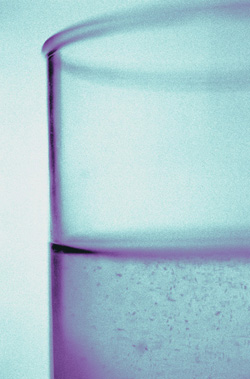A Supercool Solution

An ultracold solid with randomly packed molecules should eventually turn crystalline if you heat it up. Now researchers have found that in small amounts, a combination of two flash-frozen chemicals actually resists crystallization. Oddly, the duo instead forms a viscous “beaker without walls,” a tiny liquid-like film that holds its shape even as its molecules intermingle. The finding, reported in the 17 June print issue of PRL, may offer a new way to study supercooled solutions, mixtures that stay liquid well below their normal freezing points.
Chilling liquids is delicate business. Do it fast enough and you get a disordered, or amorphous, solid. Drag things out, however, and the molecules have time to orient themselves into crystalline form. The same goes for solutions, liquids containing more than one compound. Understanding this competition between the two different types of transition could also help researchers explain the behavior of supercooled solutions. These are found in cloud and aerosol formation, precipitation, and the antifreeze processes of certain cold-loving organisms.
Now Bruce Kay and his colleagues at the Pacific Northwest National Laboratory in Richland, WA, have found a new way to study supercooled solutions. First they deposited separate layers of methanol and ethanol onto a platinum surface at 20 K, producing an amorphous film a few millimeters wide and just nanometers high. Next, they gradually heated the film and analyzed its vapor with a mass spectrometer. During heating, the detector registered the same proportions of vapor from both compounds, regardless of which had been deposited first, proving that the sample became a liquid solution at temperatures where the two chemicals should have crystallized. Theorists had suspected that such a mixture might resist crystallizing from the amorphous state because its different-sized components wouldn’t line up, just as a jumbled box of oranges and grapefruit would have trouble settling into a regular pattern.
Although the film became liquid, it simultaneously held its overall shape, like a solid. The group calculated that the solution must be 1000 times more viscous than honey, explaining how this squat little “beaker” could stay in shape with no walls to support it.
The group’s real achievement, though, says Gilbert Nathanson of the University of Wisconsin in Madison, was to find a way of teasing apart the interplay between molecules in a highly supercooled solution, via evaporation. “The preparation of nanometer thick films is the trick,” he notes. When the films are thicker, the two kinds of molecules can’t mix fast enough to escape the crystallization process, so there’s no solution to study.
Kay and colleagues next plan to study supercooled solutions made from water and other chemicals, varying the thickness and temperature of the films to see how this affects crystallization. “The unknown in liquids in general is how the structure of the liquid changes with time and temperature,” Kay says. “Any techniques that could shed light on that could be useful.”
–JR Minkel
JR Minkel is a freelance science writer in New York City.


